 Ancient plant wisdom meets nanotechnology
Ancient plant wisdom meets nanotechnology
By Vince Giuliano May 28, 2019
This blog entry is concerned with a new dietary supplement that my colleagues I have sourced, called 4 Herb Synergy. It is concerned with the scientific considerations we have had in mind in the process of creating the supplement, the molecular mechanisms we believe are responsible for how it works, and the vehicle preparation for enhanced bioavailability. After 4 years of development, the first commercial batch of the product has been produced and we should be selling it online in less than a week now.
This blog entry is focused on the science related to the 4 Herb Synergy supplement. It is a companion to the simultaneously published blog entry On the Making of a Dietary Supplement, which is basically a highly personal story of the history of creation and fine tuning of the supplement.
Based on the preponderance of research described here, we can conservatively represent that 4 Herb Synergy supports a healthy response to chronic inflammation. Please see the medical claims disclaimer at the end of this blog entry. These statements have not been evaluated by the Food and Drug Administration. Any new product described in this blog is not intended to diagnose, treat, cure, or prevent any disease.
This is Part 6 of what will likely be a nine-part series of blog entries related to chronic inflammation. Being a central aspect of every degenerative disease of old age, chronic inflammation can be thought of as the Great Executioner, the most central machinery of most people’s ultimate illnesses and deaths. Parts 1 through 5 of this series are already published. Part 1 of the series is the same as Part 5 of the NAD world. That blog entry is concerned with The pro-inflammatory effects of eNAMPT (extracellular NAMPT, nicotinamide phosphoribosyltransferase). Part 2 of the series relates a) the “master” pathway network of inflammation (NF-kB) to two other pathway networks clearly implicated in aging and disease processes, b) Genomic Instability (p53), and c) Oxidative stress (Nrf2). Part 3 is concerned with the all-important resolution phase of inflammation, how acute inflammation goes away under ideal conditions instead of hunkering down to lingering and dangerous chronic inflammation. Part 4 of the inflammation series, is concerned with PCSK9 inhibition – Also that blog entry is Part 1 of a series on interventions that reduce all cause mortality (ACM). Part 5 of the series is concerned with the basic science of inflammasomes and how they relate to a number of disease processes.
THE HERBAL INGREDIENTS IN 4-HERB SYNERGY
The supplement is a liposomal preparation of four herbal ingredients, extracts of traditional and well-researched herbs which we believe act synergistically: curcumin, boswellia, ginger and ashwaghanda. The extracts are each standardized to multiply concentrations of the bioactive chemical component thought to be most beneficial. For more rapid and complete body uptake, ingredients are encapsulated in liposome capsules made out of a phosphatidylcholine complex, a form of non-GMO sunflower lecithin, topped off with a bit of Vitamin C and natural cinnamon flavoring.
CURCUMIN
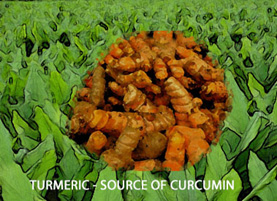
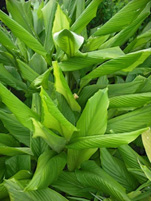
Curcumin is the principal active ingredient in turmeric, a plant with a history of medicinal use going back over 4,000 years in the Ayurvedic tradition. it has served as a principle spice in Southeast Asia and played an important role in religious ceremonies. It showed up in China around 700 AD, in East Africa around 800 AD, in West Africa around 1200 AD, and in Jamaica around 1750. In Chinese Medicine it is known at Jiang Huang
Contemporary medical researchers begin investigating curcumin over 25 years ago and the PubMed database of the National Library of Medicine currently contains 13,255 research publications related to curcumin (Up from 11,865 only seven months ago.) In response to infection or cellular stress, inflammasomes are assembled, activated, and involved in Of these, 1599 articles are concerned with curcumin and inflammation. (Note: numbers of publications are as of latest date I reviewed this material before publishing this blog, and are constantly increasing, indicating how hot the field of these nutraceuticals is.) Many of these articles are related to curcumin’s capability to control inflammation and cancers via inhibiting the NF-kB pathway, the “master pathway” of inflammation. Curcumin differentially regulates 67 mRNAs, inhibits unwanted apoptosis, induces autophagy and kills cancer cells.
The chemical composition of turmeric is very complex , including relatively large proportions of flavonoids, phenols and terpenoids, and moderate amount of tannins, alkaloids, saponins and steroids. Its most positively-acting bioactive components appear to be curcuminoids and terpenoids (references).
The US government database clinicaltrials.gov lists 198 clinical trial studies for applications of curcumin in various disease conditions. (This number has increased from 152 in just the year since the first draft of this material.)
Curcumin is already a very popular dietary supplement. A 2018 market research study indicates “The global curcumin market size was estimated at USD 44,246.3 thousand in 2016 and is projected to register a CAGR of 13.3% over the forecast period (to 2025).”
However, bioavailability of curcumin is very limited. “Clinical trials in humans indicate that the systemic bioavailability of orally administered curcumin is relatively low (3-5) and that mostly metabolites of curcumin, instead of curcumin itself, are detected in plasma or serum following oral consumption (6, 7)(ref).” That is why liposomal preparations of curcumin such as in 4 Herb Synergy are believed to have a significantly greater capability of reaching the body organs where the herbal chemicals can make a difference.
The turmeric extract in 4-Herb Synergy is standardized to 95% curcuminoids.
BOSWELLIA
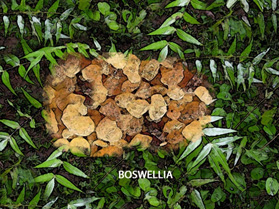

In Ayurvedic medicine a gummy resin from a branching tree, Boswellia Serrata, is one of the most ancient and valued herbal remedies. Extracts of Boswellia serrata have been traditionally used in folk medicine for centuries to treat various chronic inflammatory diseases. As described in ancient Sanskrit texts 600 to 700 B.C., it is an effective remedy for skin and blood diseases, diarrhea, dysentery, ringworm, boils, fevers (antipyretic), cardiovascular diseases, asthma, bronchitis, liver maladies, chronic mouth and throat soreness, hemorrhoids, and a number of other conditions.
We know the gum from biblical times as Frankincense. In Chinese medicine, it is known as Ru Xiang.
The National Library of Medicine research database PubMed lists 577 research articles on Boswellia and 94 of these are related to Boswellia and control of inflammation. Like the other herbal extracts used in 4 Herb Synergy, the chemical composition of the resinous part if Boswellia Serrata is very complex. It contains four major pentacyclic triterpenic acids which are capable of inhibiting pro-inflammatory enzymes. These are β-boswellic acid, acetyl-β-boswellic acid, 11-keto-β-boswellic acid and acetyl-11-keto-β-boswellic acid. Out of these four boswellic acids, acetyl-11-keto-β-boswellic acid, known as AKBA, is the most potent inhibitor of 5-lipoxygenase, an enzyme responsible for inflammation. The extract used in making 4 Herb Synergy is particularly enriched for the presence of AKBA. Research shows that the enzyme 5-lipoxygenase inhibited by AKBA plays a major role in the formation of leukotrienes, which stimulate and perpetuate inflammation. This inhibition results in significantly reduced levels of inflammatory mediators (IL-1β, IL-6, TNF-α, IFN-γ and PGE2), and increased level of IL-10.
The US government database clinicaltrials.gov lists 11 clinical trial studies for applications of boswellia in various disease conditions.
Bioavailability of boswellia is quite limited, as is the case for curcumin. That is why we think a liposomal preparation of boswellia such as in 4 Herb Synergy has a significantly greater capability reaching the body organs where the herbal chemicals can make a difference.
The Boswellia extract in 4-Herb /synergy is standardized to 30% AKBA.
GINGER
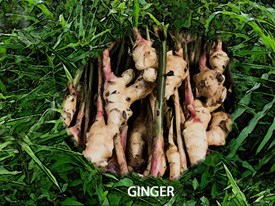
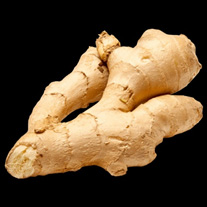
Ginger, the “root” or the rhizome, of the plant Zingiber officinale, has been a popular spice and herbal medicine in the Ayurvedic tradition for thousands of years. It plays a central role in many other traditions of folk medicine as well, in China, in ancient Greece, throughout the Middle East and Asia. Ancient texts suggest that its use has been strongly associated with wealth, power, and commerce. Explorers like Marco Polo and Vasco da Gama were concerned about where it was grown and how to get it back to European capitals. In Europe you had to be very rich to get the herb back when they were alive.
In folk medicine the medicinal applications of ginger are widespread and vary to some extent by society and culture. In several ancient societies, ginger was viewed to have spiritual, aphrodisiac, general healing, and life-extending powers. Ginger is mentioned in ancient religious texts like the Quran; “Allah says ginger will be one of the drinks that will refresh the believers in paradise.” In ancient ayurvedic texts ginger is recommended for painful and inflamed joints, and improving digestion and elimination. In China, ginger has been used to help digestion and treat stomach upset, diarrhea, and nausea for more than 2,000 years.
The PubMed database of the National Library of Medicine currently contains 3394 research publications related to ginger. Of these, 223 articles are concerned with ginger and the control of inflammation.
The primary active ingredients in ginger are known as gingerols. These suppress the production of pro-inflammatory molecules (TNF-alpha and interleukin subtypes including IL-1β and IL-6). They inhibit PI3K/Akt and NF-κB signaling, decreases inflammatory biomarkers NO and hs-CRP, and reduce levels of oxidative stress in several cell types.
The US government database clinicaltrials.gov lists149 clinical trial studies for applications of ginger in various disease conditions.
The Ginger extract in 4-Herb /synergy is standardized for its content of gingerols..
ASHWAGHANDA
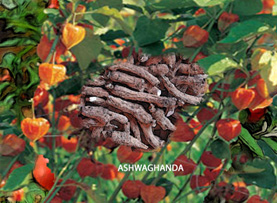
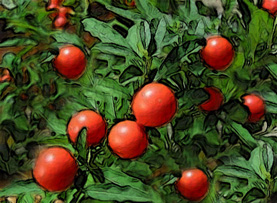
Ashwaghanda (Withania somnifera) is another highly esteemed Ayurvedic herb with history of use going back more than 4,000 years. The plant’s root has been used in traditional remedies for inflammation, ulcers, fatigue, cough, rheumatism, gynecological disorders, emaciation, sore eyes, and mental disorders. In the Ayurvedic tradition, Ashwagandha is classified as a rasayan, a rejuvenating or life-extending agent.
The PubMed database of the National Library of Medicine currently contains 1099 research publications related to ashwaghanda. Of these, 67 are concerned with ashwaghanda and control of inflammation. The active ingredients in ashwaghanda are known as withanolides.
Withanolides down-regulate iNOS and suppress the production of pro-inflammatory molecules (TNF-alpha and interleukin subtypes). The anti-inflammatory properties of withanolides have been researched extensively, including as they affect the NF-κB, JAK/STAT, AP-1, PPARγ, Hsp90 Nrf2, and HIF-1 pathways. Aswaghanda appears to upgrade presence of the longevity factors FOXO3A and SIRT3 in serum. There has been continuing investigation of the clinical application of withanolides in inflammation-mediated chronic diseases, including arthritis, other autoimmune diseases, cancers, and neurodegenerative diseases.
The US government database clinicaltrials.gov list three clinical trial studies for Aswaghanda.
The proprietary ashwaghanda extract in 4-Herb /synergy is standardized to 10% withanolides.
The inflammation-related science behind the 4 Herb Synergy concept
4 Herb Synergy has not yet been subject to clinical trials that would be necessary to justify any medical claims made for the substance. So I have to declare again that This product is not intended to diagnose, treat, cure, or prevent any disease. And, these statements have not been evaluated by the Food and Drug Administration.
Inflammation is a generic term for a large number of bodily reactions that differ in detail by cause, by organ and in impact. Inflammation is a bodily reaction to stresses that is ancient, present in all animals, natural, key to wound healing and essential for us to keep living in health. It is a phase of stress responses that is transitory and in healthy circumstances self-resolving. The last thing we would want is to get rid of all inflammation, for that would soon kill us. Chronic inflammation on the other hand is a different situation, triggered by some diseases and serious stresses, increasingly common with advanced aging, persistent and unresolving. And it is itself the cause of many dangerous and deteriorative processes. So the objective of any intervention to control inflammation, including any dietary supplement, is to limit and control chronic but not acute inflammation. A series of blog entries already referenced expands on these points and explores the extreme complexities of inflammation. 4 Herb Synergy is targeted to inhibit many common forms of chronic inflammation, but far from all forms of inflammation. And I see this as good.
Synergy in the control of inflammation
Because the herbal ingredients in 4_Herb Synergy act through different molecular mechanisms as indicated above, we believe they are likely to act synergistically in the control of chronic inflammation. Yet, both acute and chronic inflammation are very complicated. There are a large number of risk factors and potential sources of chronic inflammation, including disease processes, environmental causes and advanced aging itself. And there are a large number of circumstances in which it can become manifest, gum infections, trauma injuries, joint pains and some dementias being only a few items on the list. And similarly there are various approaches to controlling inflammation which vary in their effectiveness. Because inflammation is a critical body mechanism for dealing with threats and diseases we would definitely not want to wipe it out completely if we could. Acute attacks of inflammation can justify the use of steroids like prednisone, and the medical; establishment should be entrusted in such situations. And even for the resolution of chronic inflammation, it may be wise to pursue additional dietary and other approaches. Again, our point here is not to provide medical advice. People experiencing serious inflammatory conditions should consult with a medical professional.
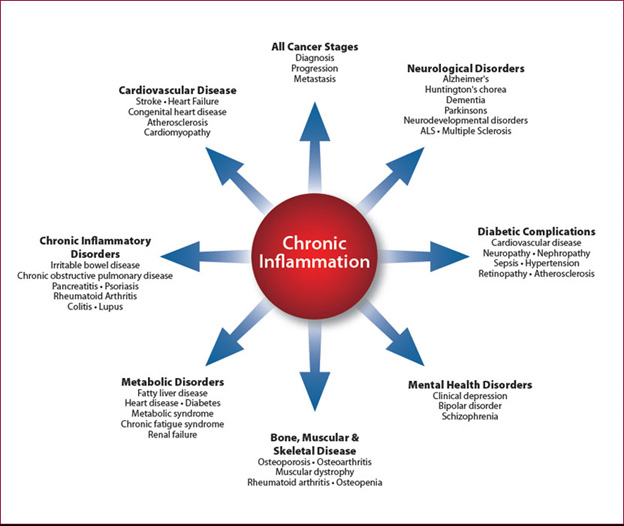
There is a large number of causes for initiation of inflammation as a response of the innate immune system. These include numerous disease conditions, pathogens and toxins, and insect bites, all associated with numerous PAMPs (pathogen associated molecular patterns) and DAMPs (danger-associated molecular patterns). Likewise there are numerous manifestations of inflammation, many of which are organ-specific or disease-specific with their own etiologies and manifestations. Inflammation of the brain as in Alzheimer’s disease shows up and acts very differently than does inflammation of the joints in osteo-arthritis. What all forms of inflammation have in common, however, is activation in cells of a protein NF-kB, and its translocation to the nucleus of cells where it triggers the production of pro-inflammatory cytokines. Research has established that each of the herbal ingredients in 4 Herb Synergy in its own ways inhibits the expression of NF-KB. This is the simplest explanation of how it works.
While there is no published scientific literature yet on 4 Herb Synergy itself, there are significant bodies of research on each of its ingredients, as linked to above, and on bioavailability and liposomal formulations. While I could generate a lengthy and detailed blog entry on these facts, I confine myself here to a few summary and highlight statements. In particular, Jim Watson and I have written extensively about two key pathways that are central to health and vitality, NRF2 and NF-kappaB. In a couple of nutshells:
NRF2
Each of the herbal components in 4 Herb Synergy promote the expression of NRF2, a transcription factor that plays a key role in activating some 240 genes that are parts of the body’s own antioxidant and stress-protective systems. These genes up-regulate production of endogenous anti-oxidant proteins, stress response mechanisms, and drug metabolism and detoxification enzymes. The science related to NRF2 is well-established and supported by hundreds of research studies and publications. Check out these blog articles we have written on NRF2: –
– NRF Part 2 – Foods, phyto-substances and other substances that turn on Nrf2, and
NF-kB
As already mentioned, each of the herbal components of 4 Herb Synergy also inhibits the activation of NF-kB (Nuclear factor kappa-B), another pathway involving activation or suppression of multiple genes and often called “the master pathway of inflammation.” Control of chronic inflammation is critical in maintaining health, particularly in the face of stresses and aging. Chronic inflammation can involve a very complex set of processes and management of it has been of concern for years to us creators of 4 Herb Synergy.
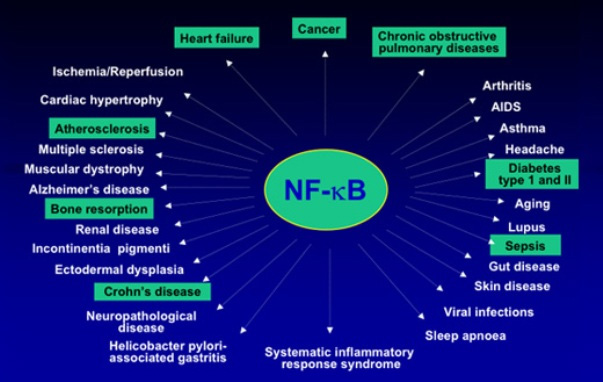
Image source Conditions associated with NF-kB expression and chronic inflammation
Among the articles recently written by or contributed to by me on inflammation are:
– Inflammation Part 3: resolving inflammation – resolvins, protectins, maresins and lipoxins
– Inflammation Part 4 – PCSK9 inhibition
– Inflammation Part 5: Inflammasomes – science of and disease implications
– AGING, CELL AND TISSUE REPAIR, RENEWAL AND REGENERATION, INFLAMMATION AND THE SASP
Aging, Inflammation, Disease Processes, and Longevity
A great many researchers appear to have reached a consensus that constitutional inflammation increases with advanced aging and that this inflammation sources most if not all of the diseases characterizing the final stages of human life: cancers, diabetes, cardiovascular issues, dementias, etc. The process has been characterized by the term “inflammaging.” A recent contribution to the extensive literature on this topic is the 2018 publication Inflammation, inflammaging and cancer, from which L have extracted the following quote:
“Numerous evidences show how apparently different age-related pathologies, including cancer, cardiovascular diseases and type 2 diabetes reveal a common inflammatory background [7, 8]. Epidemiological studies demonstrate the relationship between increased levels of inflammatory mediators like Interleukin(IL)-6 or C-reactive protein (CRP) to multiple age-related diseases [9]. In fact, inflammaging is characterized by the establishment of a systemic proinflammatory state with increased level of circulating interleukins such as IL-6, IL-1 and Tumor Necrosi Factor(TNF)-α and inflammatory markers, such as CRP [6]. This results from the activation of signalling networks critical to inflammation, such as those regulated by the Nuclear Factor (NF)-kB transcription factor, along with a variety of different sources of the inflammatory stimuli triggering and sustaining inflammaging, such as senescent cells, the meta-inflammation, the gut microbiota and nutrition [10, 11, 12]. — In the nineteenth century Rudolph Virchow was the first to hypothesize a connection between inflammation and cancer, but only in the last two decades researchers have produced striking evidences on the role played by the inflammatory process in promoting cancer [13, 14]. Indeed, not only cancer can arise on sites of chronic inflammation but also a pro-inflammatory microenvironment, supported by inflammatory cells and mediators, is an essential component of cancer and one of its hallmarks [15, 16, 17]. — Chronic inflammation is, thus, associated with all stages of cancer development increasing its risk, supporting cancer initiation, promoting cancer progression, and supporting metastatic diffusion [10]. Recently, it has been demonstrated that preventive treatment with anti-inflammatory drugs like aspirin reduce the incidence and mortality for colorectal cancer [18]. This leads the way to the potential preventive and therapeutic role of the modulation of cancer-associated inflammatory microenvironment [19]. — The aim of this review is to explore the role of the main actors contributing in the development of inflammaging and cancer.”
Bioavailability and Liposomal formulation of 4 Herb Synergy
Powerful as the herbal extracts that I’ve discussed above are, there are serious limits to their cellular absorption when they are consumed orally. This seriously limits their biological effectiveness. The central innovation of 4 Herb Synergy is combining a group of synergistically operating anti-inflammatory herbal extractds in a liposomal formation to greatly enhance bioavailability/cellular absorption.
Limit of bioavailability of herbs
For many herbs as well as for certain drugs, limited cellular absorption may very seriously limit the degree of control of chronic inflammation or pain that can be realistically achieved with an ingested substance. This has to do with a consumed substance getting to where it is needed in the body. An orally consumed substance targeted to a cell organelle such as mitochondria in the brain has to get:
- Past the gut bacteria
- Past the stomach acid
- Through the intestinal wall and into the bloodstream via the portal vein
- Past the liver whose job is detoxification and removal of unrecognized substances
- Avoid the kidneys so it is not peed out
- Through the blood-brain barrier
- Through cell membranes
- Through nuclear and mitochondrial membranes within cells
For some herbal substances like resveratrol and curcumin, only a tiny fraction of what is ingested can get past these barriers. Studies in rats for example have shown that less than1% of orally consumed curcumin make it into the plasma, less for humans. See the 2014 research publication Recent Developments in Delivery, Bioavailability, Absorption and Metabolism of Curcumin: the Golden Pigment from Golden Spice. Even lesser amounts of orally consumed curcumin can get through into the brain, and much less into brain cells and cell organelles. Drastically upping the ingested dose is not an option because that leads to liver toxicity. So for example, curcumin which is highly effective in killing certain deadly cancer cells in a test tube like gliablastoma, cannot be given orally in doses high enough to impact on such cancers in the brain. Such bioavailability limitations exist to varying extent for other herbs administered to control inflammation and associated pain. One very common approach to enhancing bioavailability and supplement pills has been to add substances, such as adding black pepper extract to curcumin, but the resulting increase in bioavailability tends to be quite limited.
Nano and liposomal drug and supplement delivery
The limits on cellular absorption has led the pharmaceutical industry, and more recently some researchers in the dietary supplement industry (including us), to investigating and pursuing means for increasing cellular absorption. In fact, enhancing cellular absorption is probably the main frontier insofar as enhancing the capabilities and effectiveness of herbal substances is concerned. A number of approaches have been shown to be effective for enhancing cellular absorption of the herbal substances. See for example Bioavailability enhancers of herbal origin: An overview. (2013). “Nowadays with the advancement in the technology, novel drug delivery systems open the door towards the development of enhancing bioavailability of herbal drug delivery systems. For last one decade many novel carriers such as liposomes, microspheres, nanoparticles, transferosomes, ethosomes, lipid based systems etc. have been reported for successful modified delivery of various herbal drugs.“ We believe the greatest promise lies in using nanotechnology approaches where the effective bio availability might be increased by a significant factor. In these approaches the active substances are encapsulated in extremely tiny nano-sized delivery packages which can evade or pass directly through most of the body barriers mentioned above.
The 2014 publication Nanotechnology-based drug delivery systems and herbal medicines: a review describes the situation: “Herbal medicines have been widely used around the world since ancient times. The advancement of phytochemical and phytopharmacological sciences has enabled elucidation of the composition and biological activities of several medicinal plant products. The effectiveness of many species of medicinal plants depends on the supply of active compounds. Most of the biologically active constituents of extracts, such as flavonoids, tannins, and terpenoids, are highly soluble in water, but have low absorption, because they are unable to cross the lipid membranes of the cells, have excessively high molecular size, or are poorly absorbed, resulting in loss of bioavailability and efficacy. Some extracts are not used clinically because of these obstacles. It has been widely proposed to combine herbal medicine with nanotechnology, because nanostructured systems might be able to potentiate the action of plant extracts, reducing the required dose and side effects, and improving activity. Nanosystems can deliver the active constituent at a sufficient concentration during the entire treatment period, directing it to the desired site of action. Conventional treatments do not meet these requirements. The purpose of this study is to review nanotechnology-based drug delivery systems and herbal medicines.”
The nanotechnology approach used in 4 Herb Synergy is to encapsulate herbal ingredients into liposomes, extremely tiny pouch-containing particles of a phospholipid material, these particles are typically between 80 and 250 nm in size, too small to be seen through an optical microscope. The advantages of this approach are:
- Liposomes are “natural.” They are used in several biological systems and are found, for example, in human mother’s breast milk.
- The pouch- containing vehicles are made of a completely natural substance commonly found in cell walls, phosphatidylcholine (aka lecithin)
- Lecithin is also known to be health conveying, and is it commonly sold as a dietary supplement.
- Compared to other approaches liposomes are relatively easy to make and the technology for making liposomes is relatively familiar.
The use of liposomal delivery to increase bioavailability has been researched extensively in the pharmaceutical industry, and has been of growing importance. About 20 years ago the first liposomal drug was approved for clinical use, the anti-cancer drug doxorubicin. It is believed that liposomes are longer retained in blood circulation and accumulate at pathological sites (tumours or inflamed tissues), leading to higher efficacy and lower systemic toxicity compared to the free drugs or herbal substances they encapsulate. “The application of liposomes to assist drug delivery has already had a major impact on many biomedical areas. They have been shown to be beneficial for stabilizing therapeutic compounds, overcoming obstacles to cellular and tissue uptake, and improving biodistribution of compounds to target sites in vivo. This enables effective delivery of encapsulated compounds to target sites while minimizing systemic toxicity(ref).” Liposomal dietary supplements delivering herbal ingredients have been much slower to appear in the marketplace, only in the last few years. To our knowledge 4 Herb Synergy is unique in the number and combination of ingredients it combines.
Testing 4 Herb Synergy for liposome content and size distribution
A key issue in evaluating any commercial supplement that is represented to be liposomal, Is Is it really that? Answering this is not easy. The naked eye cannot tell a liposomal product from a simple emulsion, and a powerful optical microscope can’t help either. Fortunately there is a sophisticated optical light scattering technology that can be brought to bear to tell the actual size distribution of the liposomes if they indeed exist in the product. We have had our product tested for liposomal content and size distribution on two occasions. Here is the size distribution according to a test of our original homemade product:
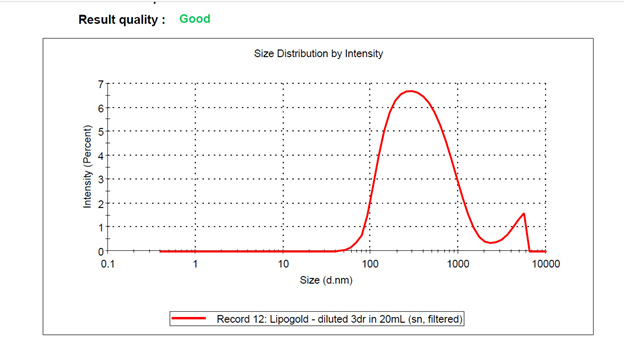
Following is a graph of the liposome size of a product batch (not of our own product) produced by our contract manufacturer using the same liposome-generating technology used in making our product.
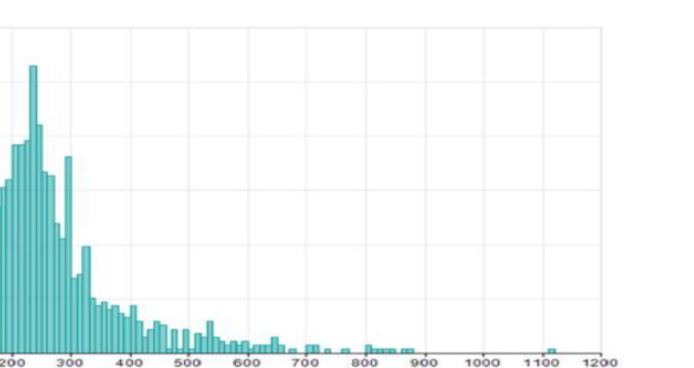
Bottom scale in both graphs is nanometers, logarithmic for our homemade sample, linear for the manufactured one. A personal objective for the original creation of 4-Herb Synergy was the control of my personal chronic inflammation underlying a painful arthritic condition.
Note that for both tests, the distributions peak at about the 200-300 nanometer size range, thought to be very good for bioavailability. The blip about 6,000 nm in our homemade product is seen by microscopic examination to be for herbal fragments due to impurities in the ginger extract we used consisting of tiny fragments of the original ginger. (Such contaminants are harmless and do not show up in the graph for the manufactured product.)
Evidence for efficacy
As of this time, evidence of efficacy of 4 Herb Synergy for controlling constitutional inflammation is limited and anecdotal. I list a few pieces of personal data for me for whatever they may be worth, well-established indicators of inflammation as measured after three years of consuming teaspoons full of 4 Herb Synergy twice a day: a: CRP of .2, b. Neutrophil to Lymphocyte ratio of 1.1, c. very low presence of the pro-inflammatory cytokines IL-1beta, IL-6 and IL20 as indicated in an inflammatory panel conducted in December 2017 and d. continuing absence of inflammatory stiffness or associated joint pains. Each of these is remarkable for someone of my age of 89 with documented earlier history of rheumatoid and osteo-arthritis.
Normal CRP, the most common test for inflammation, is 0.0 to 9.9 mg/L, and .2 is at the extreme low end. Neutrophil to Lymphocyte ratio is also a very sensitive biomarker of inflammatory state and has high predictive value for outcomes in inflammatory diseases. There are 495 published papers on this biomarker, most appearing recently. It is regarded to be a better predictive measure than CRP for mortality for several disease conditions including cancers, coronary artery disease and infectious diseases. My score of 1.1 is on the very low end with 82% of death risk for coronary heart disease associated with a value of this ratio >3. A second person who has been consuming 4 Herb Synergy shows similar scores, to the extent he/she has been tested.
MEDICAL DISCLAIMER
THE PURPOSE OF THIS BLOG ENTRY IS TO PRESENT SCIENTIFIC FACTS RELATED TO A DIETARY SUPPLEMENT RECENTLY DEVELOPED BY THE AUTHOR AND HIS COLLEAGUES. OVER THE 10-YEAR HISTORY OF THIS BLOG, WE HAVE REFRAINED FROM ACCEPTING ANY ADVERTISING OR ADVOCATING ANY COMMERCIAL PRODUCT. WE HEREIN WISH TO CONTINUE THE LONG-ESTABLISHED POLICY OF THIS BLOG , WHICH IS TO PRESENT ESTABLISHED SCIENTIFIC FACTS RELATED TO WELLNESS AND HEALTH, NOT TO PROVIDE MEDICAL ADVICE OR ADVOCATE ANY TREATMENT FOR CURE, PREVENTION OR DIAGNOSIS OF ANY DISEASE.
THE STATEMENTS IN THIS BLOG ENTRY HAVE NOT BEEN REVIEWED OR APPROVED BY THE FDA.
FROM TIME TO TIME, THIS BLOG MAY DISCUSS RESEARCH DEVELOPMENTS RELATING TO DISEASE PROCESSES. THE INTENTION OF THOSE DISCUSSIONS IS TO CONVEY CURRENT RESEARCH FINDINGS AND OPINIONS, NOT TO GIVE MEDICAL ADVICE. THE INFORMATION IN POSTS IN THIS BLOG IS NOT A SUBSTITUTE FOR A LICENSED PHYSICIAN’S MEDICAL ADVICE. IF ANY ADVICE, OPINIONS, OR INSTRUCTIONS HEREIN CONFLICT WITH THAT OF A TREATING LICENSED PHYSICIAN, DEFER TO THE OPINION OF THE PHYSICIAN. THIS INFORMATION IS INTENDED FOR PEOPLE IN GOOD HEALTH. IT IS THE READER’S RESPONSIBILITY TO KNOW HIS OR HER MEDICAL HISTORY AND ENSURE THAT ACTIONS OR SUPPLEMENTS HE OR SHE TAKES DO NOT CREATE AN ADVERSE REACTION.


Pingback: The making of a dietary supplement – the long and short histories of it - AGINGSCIENCES™ - Anti-Aging Firewalls™AGINGSCIENCES™ – Anti-Aging Firewalls™
Pingback: FUNNY THINGS ARE HAPPENING TO ME ON THE WAY TO 100 - AGINGSCIENCES™ - Anti-Aging Firewalls™AGINGSCIENCES™ – Anti-Aging Firewalls™
Pingback: YOUNGING1.0– THE EMERGING AGING REVERSAL STRATEGY - AGINGSCIENCES™ - Anti-Aging Firewalls™AGINGSCIENCES™ – Anti-Aging Firewalls™
Pingback: ANTI-INFLAMMATORY HERBAL LIPOSOMAL PROPARATIONS FOR HEALTHY AGING - AGINGSCIENCES™ - Anti-Aging Firewalls™AGINGSCIENCES™ – Anti-Aging Firewalls™